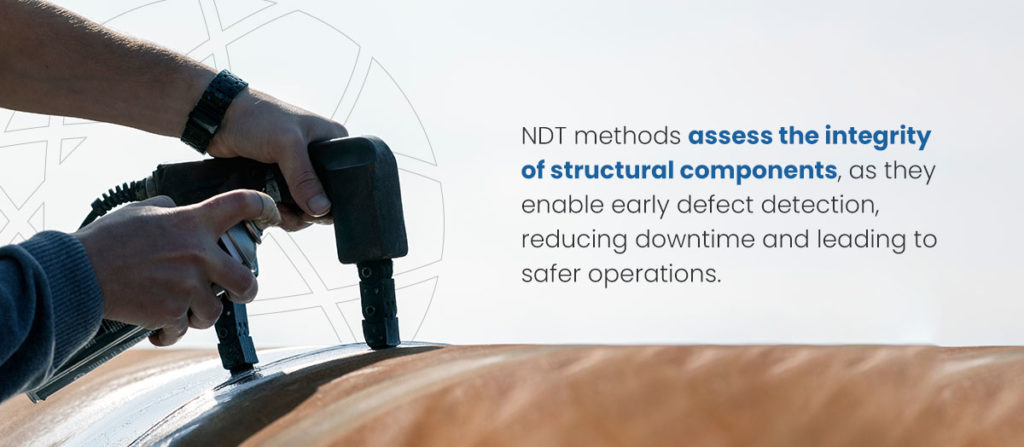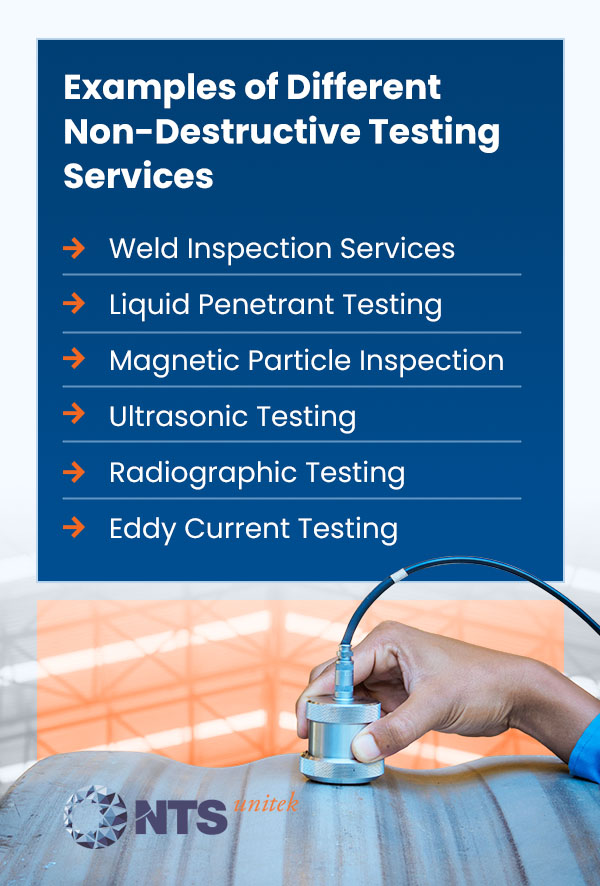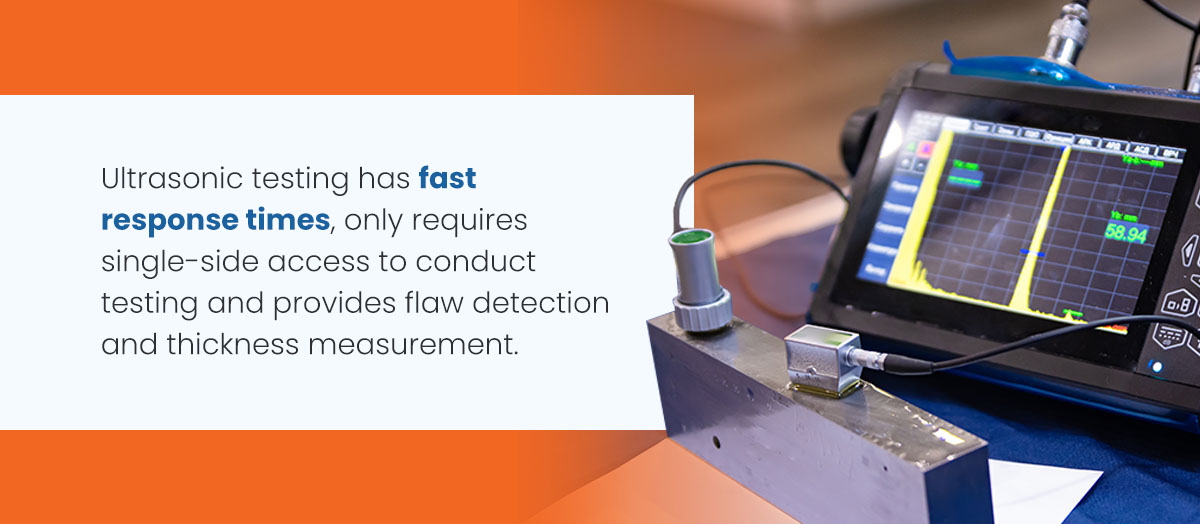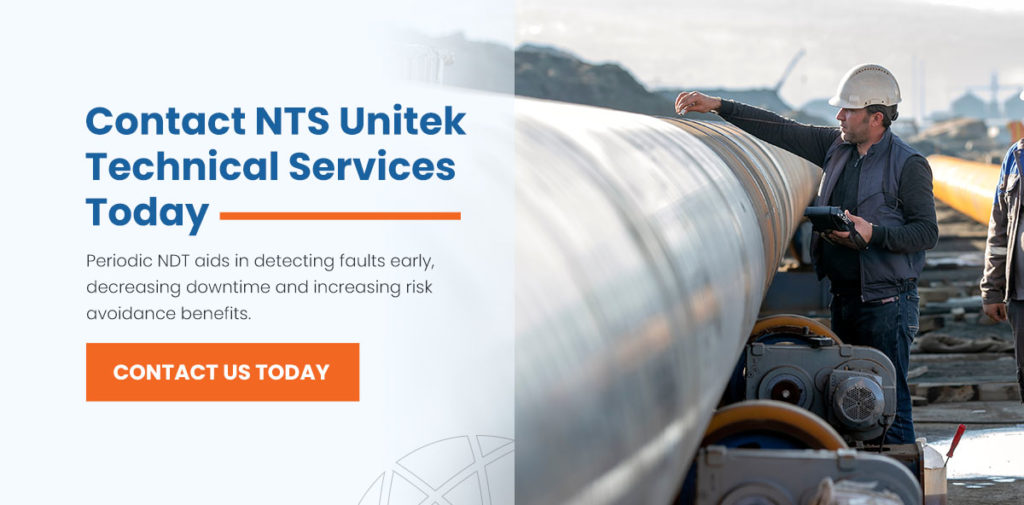Non-destructive testing (NDT) is a methodical assessment technique that inspects materials, components or structures without causing damage. The main advantage of non-destructive testing is that it preserves the object’s integrity and minimizes production disruptions. NDT methods are vital in maintaining quality, security, improved sourcing operations and compliance across manufacturing, aerospace and oil and gas industries.
Opting for NDT ensures organizations adequately maintain their assets, conserve resources, and create quick, efficient and accurate appraisals and evaluations. 100-foot examples include radiographic, eddy current, liquid penetrant and ultrasonic testing.
Differences Between Destructive and Non-Destructive Testing
Destructive and non-destructive testing methods are fundamental techniques that various industries use to assess material properties. Understanding the differences between these testing methods and their individual advantages allows for informed decision-making in product verification services.
What Is Destructive Testing?
Destructive testing involves subjecting specimens to stressors beyond their limits to ascertain precise information about properties like tensile strength and fracture toughness.
This method is less suitable for critical component testing due to the necessary destruction of the item. Examples of this testing method include tensile, impact and fatigue tests. Some examples of industries that use this testing method include automotive, electrical engineering, defensive, chemical and software development.
What Is Non-Destructive Testing?

NDT techniques analyze material characteristics, internal structures and surface conditions without impacting the object. NDT methods assess the integrity of structural components, as they enable early defect detection, reducing downtime and leading to safer operations. For example, one NDT method, ultrasonic testing, can identify internal flaws in welds or castings, enhancing product authenticity.
There are many additional benefits of using NDT in the manufacturing process:
- Increases product safety and industry compliance.
- Minimizes product cost by conserving materials and labor.
- Improves manufacturer reputation, thanks to high-quality end-products.
Non-Destructive Testing Codes and Standards
NDT codes and standards are integral to testing to establish uniformity and dependability in assessing structural integrity. Adherence to NDT codes and standards is imperative for quality control and identifying and managing risks. In industries where precision, industry compliance and verification are paramount, these regulations validate material integrity, weld quality and overall component performance.
The American Society of Mechanical Engineers (ASME), the American Society for Testing and Materials (ASTM) and the International Organization for Standardization (ISO) are prominent bodies responsible for formulating NDT codes and standards. Other organizations which contribute to the creation of NDT codes and standards include:
- American Petroleum Institute.
- American Society for Nondestructive Testing.
- NAS 410
- CP189
- French Committee for Non-destructive Testing Studies.
- Canadian Standards Association.
- Canadian General Standards Board.
Examples of Different Non-Destructive Testing Services
Explore NDT service examples below, along with details about their use cases and benefits.

1. Weld Inspection Services
These inspections within the context of NDT are performed at various stages of the manufacturing or production process. This process helps identify defects and ensure compliance with quality standards like the AS9102 First Article Inspection to promote risk mitigation, sound operation and cost-effectiveness in welded structures and components.
Pre-weld inspections ensure base materials are suitable for welding and surface conditions are conducive to quality joints. In-process inspection monitors welding parameters in real-time to prevent potential defects. Post-weld inspection assesses the final product for defects and compliance with client standards.
Common flaws in weld NDT include:
- Poor weld quality.
- Fatigue due to human error.
- Defects due to incorrect technique and environmental damage resulting from temperature extremes or using incompatible materials.
Welding NDT methods that detect these flaws include liquid penetrant testing, magnetic particle inspection, ultrasonic testing, radiography and eddy current testing.
2. Liquid Penetrant Testing
Also known as dye penetrant testing, liquid penetration testing (PT) is a non-destructive testing method that detects surface-breaking defects in various materials. Industries such as manufacturing, aerospace, automotive and construction use this technique due to its potency in identifying open discontinuities to the surface of an object or material.
The principle of liquid PT revolves around the capillary action of a liquid penetrant into flaws that might otherwise be invisible to the naked eye. The process involves these steps:
- The material surface is cleaned to ensure no contaminants interfere with the inspection.
- A liquid penetrant is applied to the surface and left to dwell for a certain amount of time. Then, the excess penetrant is removed.
- A developer, typically white contrasting powder, is applied to draw out the penetrant from the potential flaw.
- The developer visually contrasts the penetrant and background, making indications more apparent.
- There are multiple types of penetrant testing. Visible dye penetrant and fluorescent penetrant testing. Both have lighting requirements.
Advantages
Liquid penetration testing can be conducted at various stages of component manufacturing, maintenance and quality control. It is beneficial for inspecting parts with complex geometries or non-magnetic materials components.
Industries rely on liquid PT to detect potential flaws in welds, castings, forgings, machined parts and even in-service components where surface integrity is crucial. Regular liquid penetration testing helps enhance safety and ensures compliance with quality standards.
Liquid penetrant testing is also:
- Highly sensitive to fine defects.
- Compatible with a wide range of materials.
- Cost-effective.
- Ideal when quick results and minimal equipment setup are needed.
- Non-hazardous to the environment.
- Able to inspect ferrous and non-ferrous materials.
- Able to locate potential defects in hard-to-reach areas.
- Able to be used during in-service inspections.
3. Magnetic Particle Inspection
This testing method identifies surface and near-surface defects in ferromagnetic materials like iron and steel. Magnetic particle (MP) inspection relies on the principle of magnetic flux leakage and has applications in the manufacturing, aerospace, automotive, and oil and gas industries. During this process, the test material is magnetized, creating a magnetic field within the material. If defects like cracks, laps or porosity exist, the magnetic flux lines show a disruption, causing particles to accumulate at the defect site.
MP testing is often prevalent in welding inspections, manufactured components quality control, in-service machinery maintenance inspections and infrastructure assessments where parts are subject to mechanical stress and temperature variations. Due to its accuracy in detecting potential defects on or beneath the surface, MP inspections are an essential testing tool for safety-critical components where surface integrity is vital.
Advantages
This method offers rapid inspection, sensitivity to defects and more security advantages, making it an indispensable tool for ensuring the integrity of critical components. MP inspection also allows you to:
- Test with a quick and straightforward process.
- Get immediate results.
- See surface and near-surface defects.
- Transition the inspection for use in workshops or on-site.
- Examine large or small objects.
- Avoid elaborate pre-cleaning.
- Save costs, as it’s one of the more affordable testing methods.
4. Ultrasonic Testing
Ultrasonic testing (UT) is a method that uses high-frequency sound waves to inspect a material’s integrity, uniformity and properties. It’s a preferred NDT method thanks to its precision and versatility in detecting flaws, measuring material thickness, identifying material anomalies, verifying component integrity and characterizing various materials.
Ultrasonic Sheer Wave/Phased Array
Short-pulse sheer waves allow for the detection of flaws parallel to the material’s surface. This technique is advantageous for inspecting welds and other critical components. Phased array ultrasonic testing uses multiple ultrasonic testing probes at electronically controlled angles of 45 degrees, 70 degrees and 60 degrees to improve defect detection accuracy and sizing. This testing method is beneficial for complex geometries and in conducting welding inspections.
Ultrasonic Thickness
This measurement sends a sound wave through a component and measures the time it takes for the wave to reflect. By calculating the thickness reduction, this method assesses corrosion or erosion on material surfaces like pipelines or pressure vessels. Gauging thickness at just one end makes it possible to test paint thickness, ultrasonic coating thickness, and glass, plastic, ceramics and other materials.
Ultrasonic Immersion
When an object is immersed in a liquid medium, usually water, it enhances sound wave transmission and improves flaw detection in large structures like turbine blades or aircraft components. Through this method, technicians get more accuracy in readings when testing irregularly shaped components in the aerospace, automotive and manufacturing industries.
Advantages

UT methods have high penetrating power, allowing for the quick and accurate detection of minor flaws with precise determination of the flaw’s location. This testing method has fast response times, only requires single-side access to conduct testing and provides flaw detection and thickness measurement. Other advantages include:
- Exceptional penetration depth.
- Portability, flexibility and versatility.
- Environmental friendliness.
5. Radiographic Testing
This method, commonly known as X-ray testing, examines the internal structures of materials and products. It employs X-rays to produce images that reveal defects, inconsistencies or anomalies within the material. Radiographic testing (RT) is applicable across diverse industries like manufacturing, medicine, military defense, aerospace, waste management and automotive.
RT offers quantitative data, enabling the measurement of defect size and location. It allows for repeat testing with consistent results even with different operators. Moreover, with advancing digital radiography, images are picked up quickly and can be enhanced for better visualization. This streamlines the inspection process and facilitates timely decision-making.
Advantages
The nature of radiographic testing makes it a crucial tool for ensuring quality and accuracy in modern manufacturing and beyond. This testing method’s precision, speed and versatility allow it to be used on various materials, from metals to composites. This testing type also:
- Easily inspects assembled components.
- Isolates and inspects internal components.
- Requires minimum surface preparation.
- Comes with a permanent process record of the examination.
- Verifies internal flaws in complex structures.
- Inspects a large surface area at one time.
6. Eddy Current Testing
By using electromagnetic testing, this testing can detect fine defects. In this method, electronic probes run through the length of tubes or the surface of a component. The Eddy current, a phenomenon discovered in 1824, runs in the reverse direction from the current pushed by the probe into a conductive material. It is commonly used to inspect aircraft components for cracks, measure the thickness of non-ferrous coatings, identify corrosion in heat exchangers and examine welds in pipelines.
Eddy current testing (ET) offers three types of probes to use during testing. These include internal probes for in-service testing of heat exchange tubes, encircling probes for assessing rods and tubes during the manufacturing process, and surface probes to detect cracks in plates, differentiate materials, quantify wall and coating thickness and ascertain case depth.
This technique is also suited for inspecting electrically conductive materials like aluminum, copper and steel. Other industries that use this testing method include nuclear or power generation, petrochemical, transportation and manufacturing. Businesses turn to Eddy current testing when they need rapid and precise defect detection, access to both sides of a component is limited, and defects are minor, shallow or subtle under a surface finish.
ET offers these advantages:
- Reliable results due to probe sensitivity.
- Instantaneous response.
- Short preparation time.
- High scanning speeds reaching 10 meters per second.
- Automation capabilities to test uniform parts like wheels or boiler tubes.
Non-Destructive Testing Interpretation and Reporting
NDT processes are only complete once proper documentation and result reporting are concluded. After conducting NDT techniques, data analysis looks for anomalies, defects or irregularities. This process involves identifying indicators like cracks, voids or inclusions and assessing their significance based on established NDT codes and standards. This analysis requires a deep understanding of material properties, testing methods and flaw characterization.
A clear and detailed report summarizes the inspection process, findings and conclusions. Other essential points that need to be on file include inspection dates, equipment used and relevant parameters. Any indicators get a description in precise terms, with dimensional characteristics, location specifics and classification based on severity.
Finally, the report integrates relevant contextual information like material specifications and service conditions. Recommendations for further actions like repairs, reinspection intervals or component replacement are provided, depending on the evaluation of the detected indications.
Overall, the following points should be present in the final NDT report:
- Personnel field of application.
- Instrument calibration.
- Testing procedure.
- Essential variables.
- Test results.
- Map of indications.
Contact NTS Unitek Technical Services Today
Periodic NDT aids in detecting faults early, decreasing downtime and increasing risk avoidance benefits. NDT inspection services help businesses in numerous industries reduce analysis costs, minimize maintenance costs and establish the longevity of reliable operating processes.
At NTS Unitek, our certified/qualified NDT/NDE field specialists have experience and proven success in optimizing inspections, evaluating materials, components, or assemblies without destroying their serviceability, complying with all industry standards/specifications/regulatory requirements utilizing various NDT/NDE equipment. Our customers benefit from a dedicated project manager, customized customer-specific training, customer intranet development and NTS Unitek online scheduling portals.
Contact us today to get started with quality NDT services that suit your applications.

